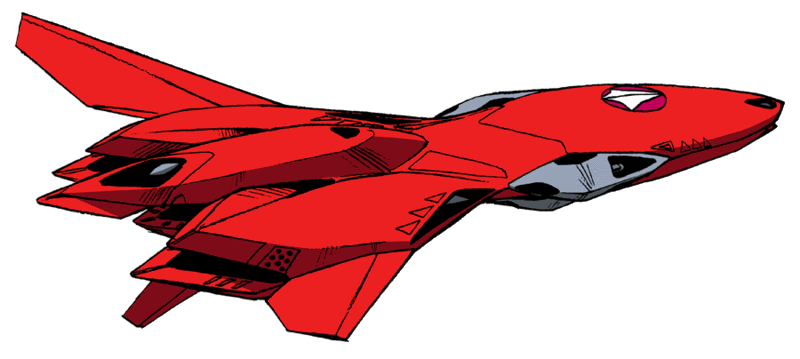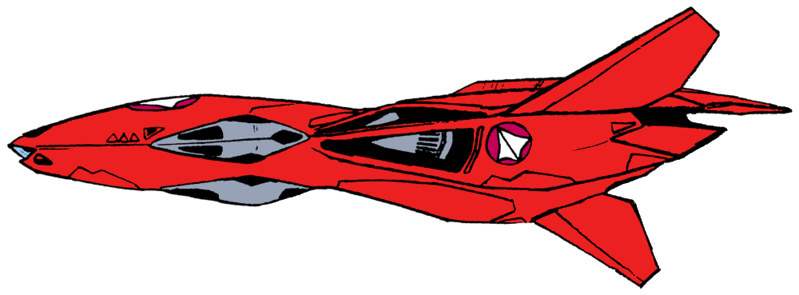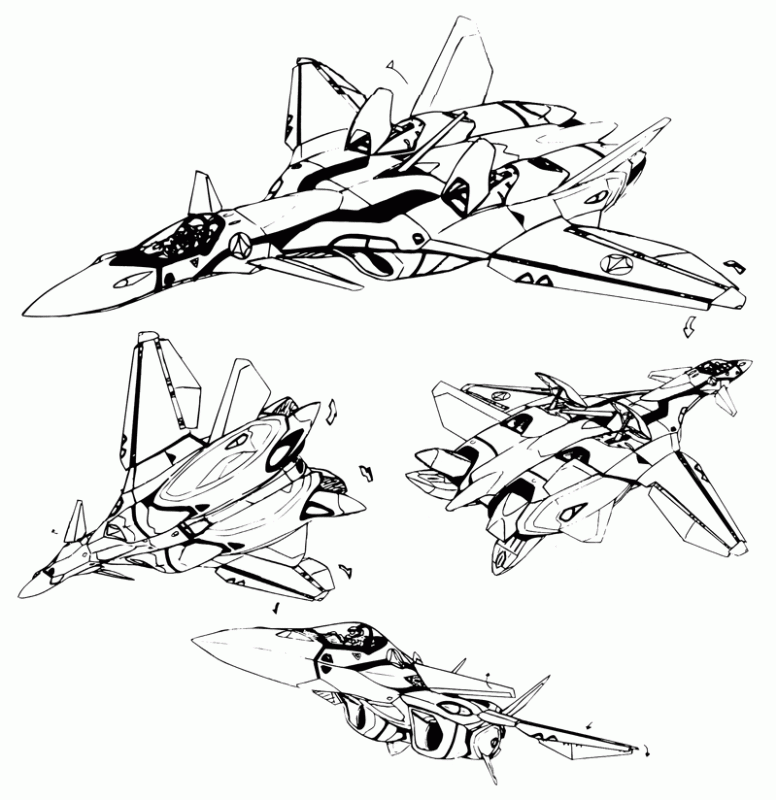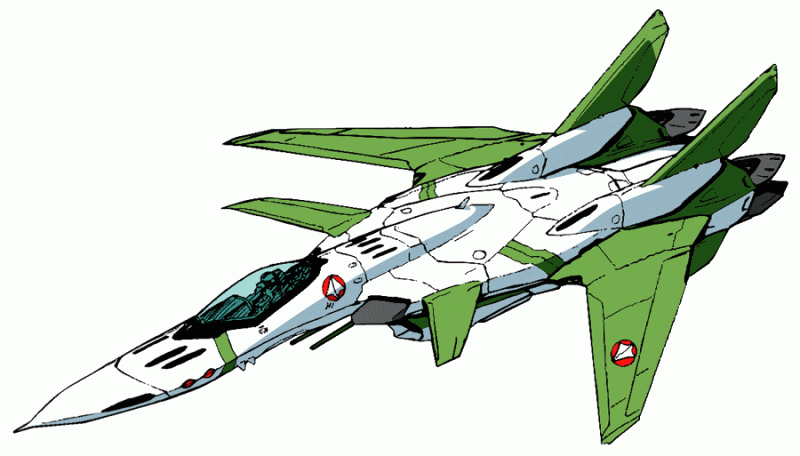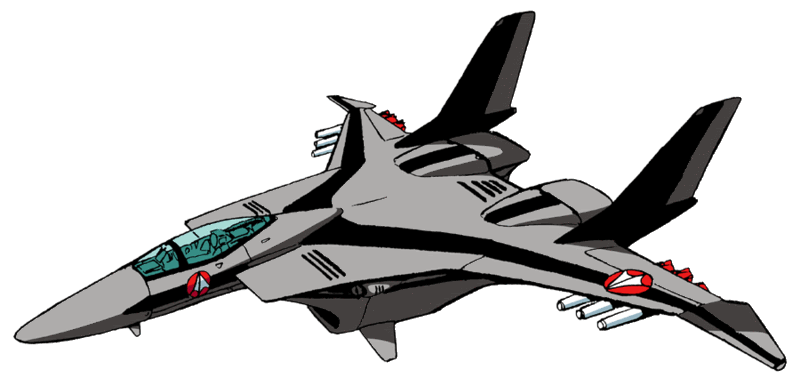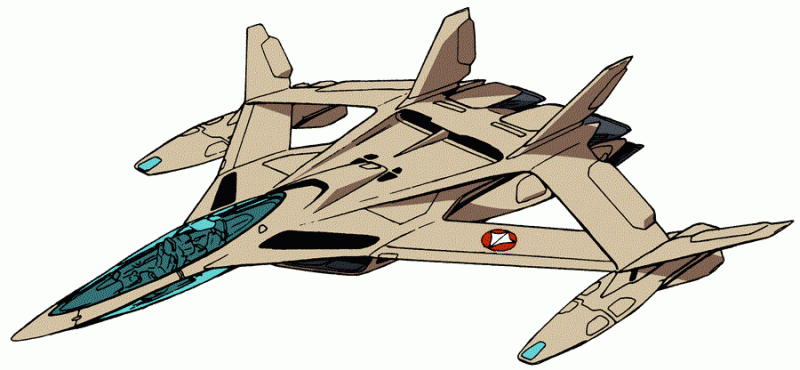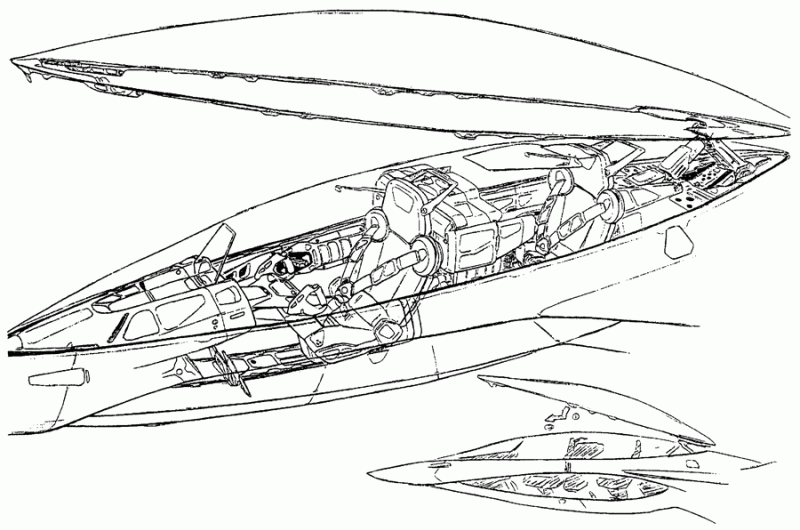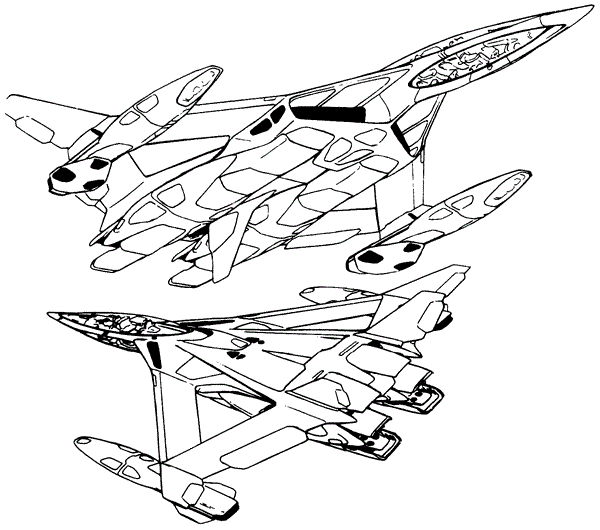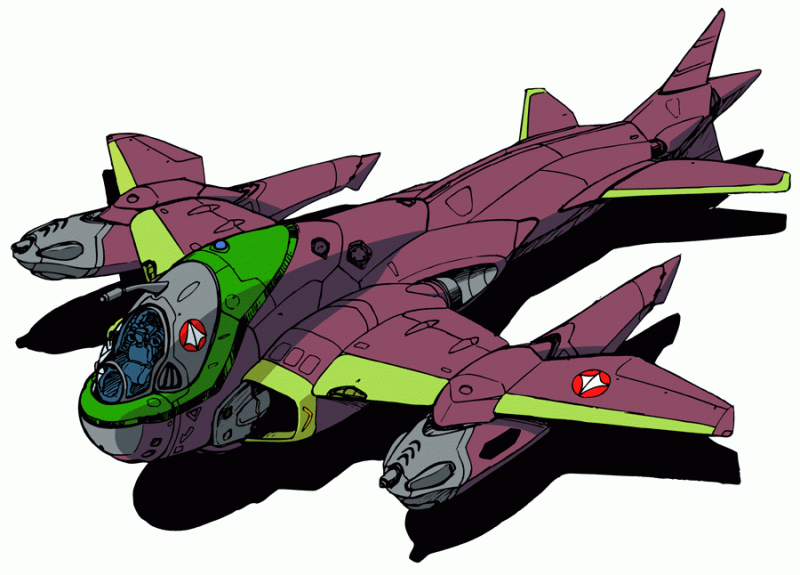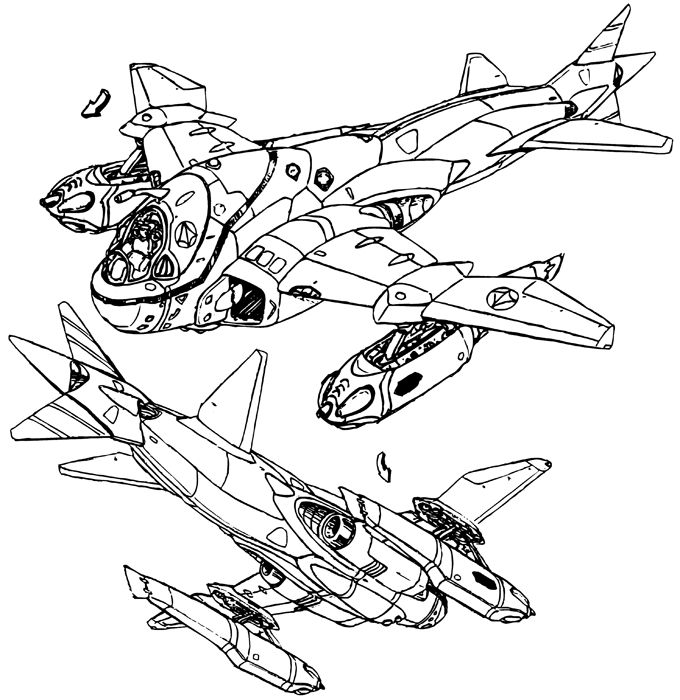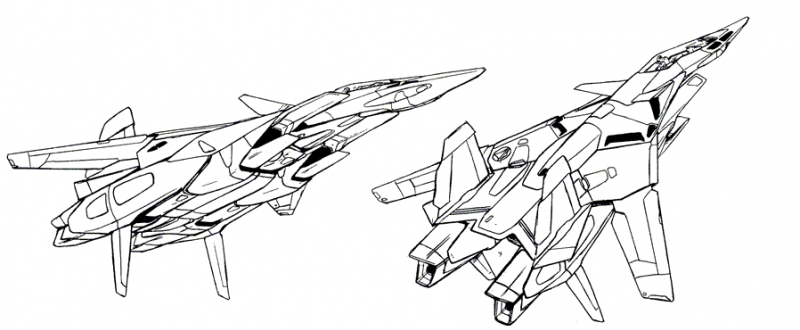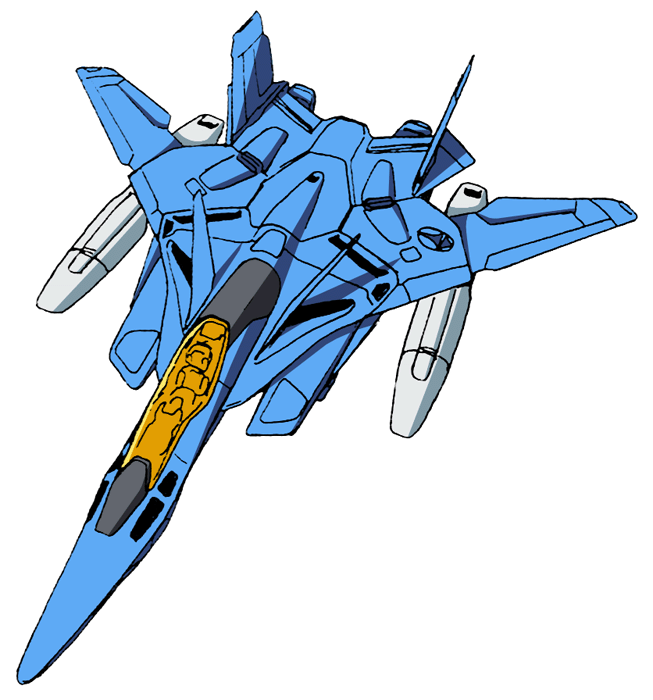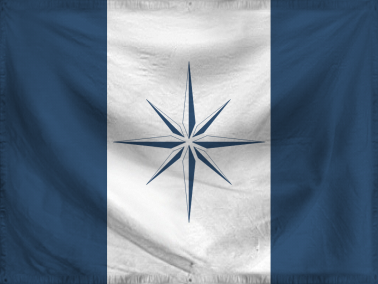
Headquartered in Denengrad, Axe & Hammer is a global security and aerospace company that employs over 120,000 people worldwide and is principally engaged in the research, design, development, manufacture, integration and sustainment of advanced technology systems, products and services.
As a global security, aerospace, and information technology company, the majority of Axe & Hammer's business is with the Denengrad Department of Defence and the New Femina Fascist Empire. In fact, Axe & Hammer is the largest provider of IT services, systems integration, and training to the Denengrad Government. The remaining portion of Axe & Hammer's business is comprised of international government and some commercial sales of our products, services and platforms.
The personal integrity of each of our employees and their commitment to the highest standards of personal and professional conduct requires more than simply complying with the laws, rules and regulations that govern our business.
We are a company that values teamwork, sets team goals, assumes collective accountability for actions, embraces diversity and promotes "full-spectrum" leaders - those who meet their performance objectives while also exhibiting the leadership behaviours we value.
Our commitment to excellence is exemplified in our Company Vision: Powered by innovation, guided by integrity, we help our customers achieve their most challenging goals.
While we remain sensitive to the diverse social and cultural settings in which we conduct our business, Axe & Hammer aims to set the standard for ethical conduct at all of our locations throughout the world.
We will achieve this through behaviour in accordance with our Company Values:
Do What’s Right: We are committed to the highest standards of ethical conduct in all that we do. We believe that honesty and integrity engender trust, which is the cornerstone of our business. We abide by the laws of the Polity of Denengrad and other countries in which we do business, we strive to be good citizens, and we take responsibility for our actions.
Respect Others: We recognise that our success as an enterprise depends on the talent, skills and expertise of our people and our ability to function as a tightly integrated team. We appreciate our diversity and believe that respect – for our colleagues, customers, partners and all those with whom we interact – is an essential element of all positive and productive business relationships.
Perform with Excellence: We understand the importance of our missions and the trust our customers place in us. With this in mind, we strive to excel in every aspect of our business and approach every challenge with a determination to succeed.
Here at Axe & Hammer, our vision is to be recognised as technology leaders throughout Denengrad and beyond. Building on our considerable presence in Government and military fields, we are using our capabilities in systems integration and prime contractorship to embrace new and exciting commercial and civil opportunities.
One of our major strengths in today's technologically sophisticated global market is our focus on forging sound partnerships and alliances, both in the Denengrad and internationally. For us, alliances with partners around the world is key to conducting business in the global marketplace.
Vision
• A leader in systems integration and high technology products and services
• Core aerospace and defence markets
• Select civil and commercial markets
• Expand Denengrad employment, exports and the technology base
• Provide excellent financial returns.
Mission
• Customer focused organisation
• Supplier of choice
• Conduit for technology cooperation
• Partner of choice
• Draw on the core A&H competencies
• Build an indigenous team
Community outreach involvement for Axe & Hammer means balanced, focused and targeted benefit to worthwhile causes across Denengrad. Supporting environment conservation, providing activities and challenges to benefit education and raising funds for various charitable foundations, either directly or via our customer community, are all examples of how Axe & Hammer strives to contribute to society.
Our employee volunteers assist in a variety of social, environmental and practical projects on behalf of the company. Our aim is to build close relationships with our community partners who surround the company's main operating sites across the country.
Axe & Hammer holds a number of events per year in support of improving the local environment for the communities in which we live. The A&H Volunteering Day is a company-wide event and tasks undertaken could include basic DIY, such as painting and decorating for less privileged establishments who have limited funding, to garden clearing and the development of sensory nature trails for special-needs schools.
Community Outreach
Axe & Hammer donates, per annum, approximately NS$50,000,000 for charitable organisations, including employee fundraising. Examples include; Hero Foundation, Clothes for the Homeless, Books for Schools, Naval Heritage Trust, Anti-Child Abuse Foundation, Cancer Research, GS3N and the Scope Foundation.
Education Outreach
From providing volunteers to help young people learn about technology and careers in engineering through to project based learning, and the provision of work placements and careers advice for teenagers, Axe & Hammer holds numerous education outreach activities to reach out to our communities.
Nations currently using Axe & Hammer products.
Denengrad
Riysa
Republic of Vectors
The Balkens
Leistungsfahig
The New World Oceania
New Neoria
Zeinbrad
Empire of Free Taiwan
Republic of the North
Tarsian
Royale Philippines
Ariel Products
Cotton Mouth Strike fighter
Fighter length: 18.69 meters
Mass: empty 16.191 metric tons
Crew: One
Propulsion: 91.08 kN x 2; 148.9 kN x 2 afterburners
Performance: at 11,000 m Mach 2.74; cruising range (with standard dorsal conformal tanks) 2,075 km; service ceiling 25,000 m
Design Features: Two-dimensional thrust-vectoring engine nozzles; standard auxillary conformal fuel drop tanks (mounted on dorsal main body); rectangular underfuselage air intake with semi-retractable slit-style shutters. Triple-system digital fly-by-wire flight control system (FCS); swing wing; air brake; 1 x AN/ALE 55 flare and chaff dispenser system; AN/ALQ 220A IDECM. ASS/PS 110 active stealth system; retractable shield canopy.

Standard CM-0 Strike Fighter
The CM series was built to benefit from several equipment packages that could enhance the fighter for specific missions. Unfortunately, the parts of the "Booster Pack" ready for deployment included only the conformal fuel tanks/missile packs. When the need to outfit the CM Mk-3 with heavy weaponry and increased fuel supply arose, Axe and Hammer personnel quickly assembled an equipment package from available parts. This special modification was known initially as the CM-0 "Raid" but was changed to the "Celestial" designation sometime afterwards, likely in response to the appearance of the craft once outfitted. When just the Savage V13 Spectre fighter was installed on the CM-0, the weight increased by approximately 35% while the total thrust of the combined CM/Savage increased less than 20%. However, the afterburner thrust increased by 90%, ultimately resulting in a marked increase in maximum acceleration.
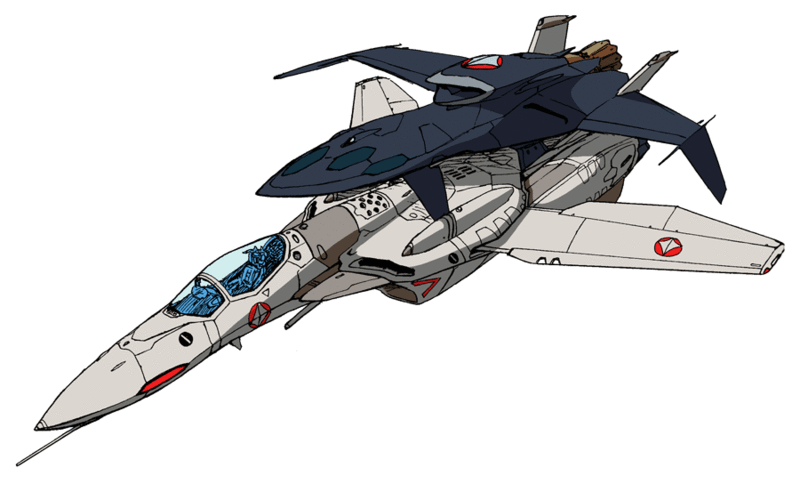
CM-0 equiped with the Savage V13 Spectre.
Axe and Hammer crew’s had to rely upon virtual simulations to produce flight data that could be input into the CM-0 air combat computer, since the CMs were modified so quickly. Several factors altered the flight characteristics of the CM-0 "Celestial" including the weight balance of the fighter's added munitions and more significantly the air flows of the CM-0 main wing as affected by the Savage V13 Spectre main wing. The complex ways in which these two wing surfaces interacted with each other at high speeds and high angles of attack left many gaps in the computer control scheme thus meaning the self-learning combat manoeuvre computer had to conduct data acquisition and analysis during flight to provide correcting actions. Coupled with the already dynamic nature of the fighters’ movements, this meant performance of the CM-0 "Celestial" configuration relied heavily upon the skills of the pilot once in actual combat conditions.
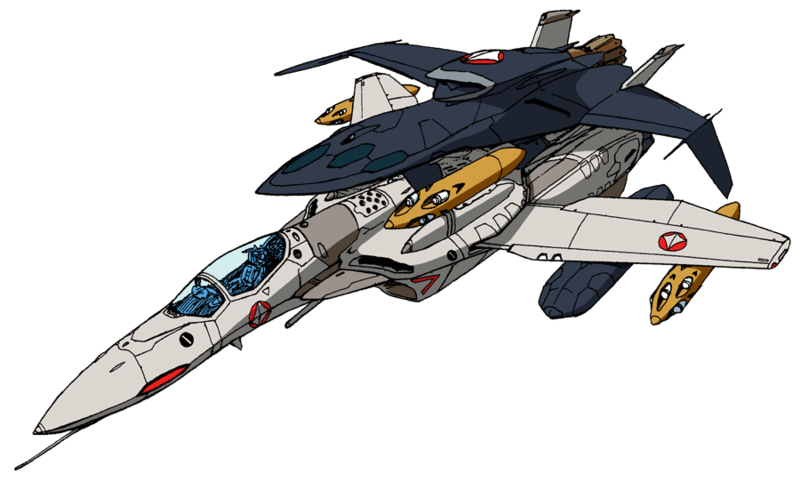
CM-0 "Celestial" fully outfitted with the Savage V13 Spectre and additional armarment and fuel tanks for increased combat time.
- Armament -
Gun:
1 x A&H three-barrel GPU-9 15mm gatling gun pod featuring adjustable rate-of-fire for 60/1,250/2,500 rounds-per-minute, driven by a 90-horsepower electric motor, muzzle velocity 1,100 m/s (650 rounds total, capable of utilizing heavy armour-piercing or AHEAD ammunition).
Bombs & Missiles:
4 x under wing variable pylon hard points for 12 x standard Raytheon Bifors AIM-200A AMRAAM 2 I/ALH-guided medium-range air-to-air missiles (three-missile racks, 1/point).
or 4 x GH-28A 8-tube general-purpose micro missile launchers (capable of firing 3 volleys).
or 2 x HAIM-95A medium-range manoeuvrability missile launcher pods originally used in attack craft equipment (special attack/assault specification).
or a combination of above load-outs
Optional Armament:
2 x external atmospheric combat Booster parts/conformal fuel tank FAST Pack with 24 x Raytheon Erlikon GH-30B I/IR-guided micro-missiles each (mounted one per engine nacelle)
2 x augmentative pylons welded to the conformal fuel tanks of craft's dorsal surface for optional special attack/assault specification.
1 x Savage V13 Spectre unmanned fighter equipped with five micro-missile launchers.
Cotton Mouth Strike Fighter – “odd” Variant
The CM-Odd is a two-seat variant of the standard CM-0 strike fighter and features larger main wings for improved range. For manoeuvrability, the CM-Odd has two large canards mounted ahead of the main wings and two ventral stabilizers near the intakes. The increased surface are of the main wing allows the CM-Odd to carry 20% greater maximum payload than the CM-0 variants and is capable of mounting most standard aviation weaponry.
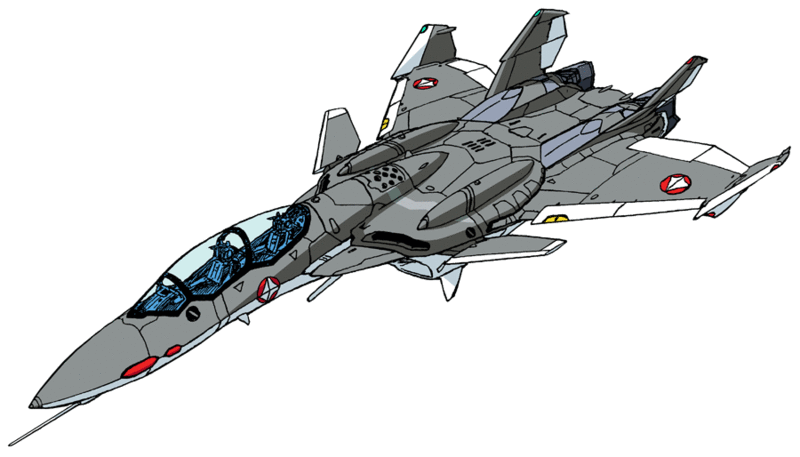
The CM-0 "Odd" Strike variant.
Savage V13 Spectre A.I Fighter - S.V.S
The Savage V13 is an unmanned stealth fighter produced by Axe and Hammer Defence for the Denengrad Air Self Defence force. The Savage V7 Ghost pioneered many of the conventional technologies for our modern unmanned fighter. The Savage’s large single engine, low mass and upward-canted forward-swept cranked gull wing makes the unmanned fighter very fast and agile. The armament of Savage V13 Spectre is two micro-missile launcher on either side of the rear ventral fuselage and one nose mounted launcher. The Savage V13 is also outfitted with a scaled down Vulcan cannon and increased ammunition capacity.
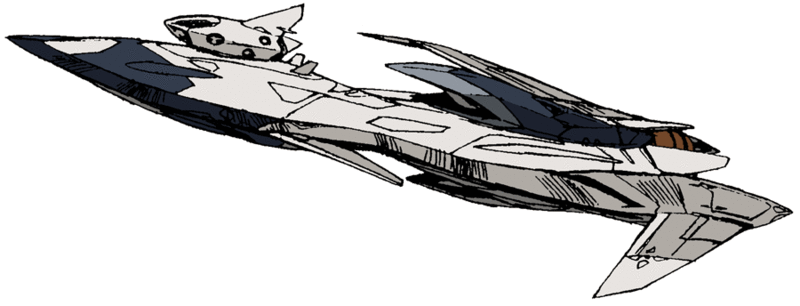
Savage V13 Spectre.
Dimensions: 9.85 meters long.
Mass: 5.70 metric tons.
Crew: None - A.I
Power Plant: one A&H hyper intake turbofan booster engine.
Performance: at 10,000 m Mach 7.0+, maximum speed due to heat-resistance limit of the fuselage (capable of attaining sub-orbit)
Maximum Airframe Design Load: 24.5G
Design Features: A&H/L.A.I. SA/A-2045 FCS2 artificial intelligence and fire control system (hierarchical programming/self-learning type); fold communication guidance system (links with AWACS); active stealth system; 1 x dorsal mounted forward-looking main sensor; 1 x ventral mounted forward-looking small sensor; integrated monitor systems and central computers located in the nose.
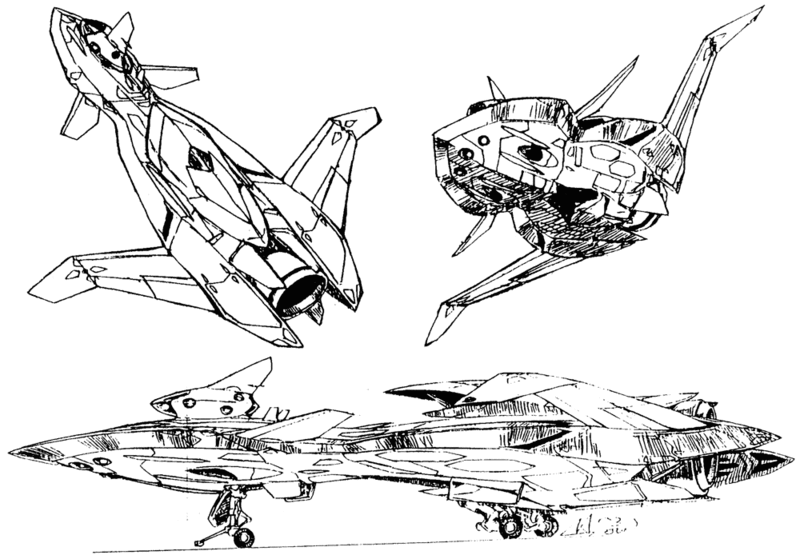
Multi-view of the Savage V13 Spectre.
- Armament -
2 x RÖV-12 12mm Vulcan gun (mounted left and right of forward fuselage)
Bombs & Missiles:
4 x built-in micro-missile launchers (large amounts of missiles can be stored inside the airframe)
Price
CM-0: - 68.9 million NSD
CM-0 "Celestial" (including Savage V13): - 92.3 million NSD
CM "Odd": - 69.3 million NSD
Savage V13 Spectre: - 23.4 million NSD
Ko Enshaku 01 Tactical Fighter
Dimensions: Wingspan 14.87 meters; height 3.94 meters; length 18.62 meters
Mass: Empty 8.75 metric tons
Crew: One (option for extra rumbler ejection seat)
Propulsion: 42,700 kg x 2 class maximum thrust (90.18 kN x 2)
Performance: Standard cruise speed 10,000 – 12,000 m Mach 1.8
Design Features: Variable geometry sweep (VG) main wing featuring forward-swept standard cruising configuration and overswept high-speed configuration (mode also used for storage); canard forward wing; two-section double-hinged cockpit canopy glass with rear canopy air deflector panels and retractable segmented canopy cover (for rear seat ejection); passive semi-active stealth systems; two dimensional thrust vectoring.
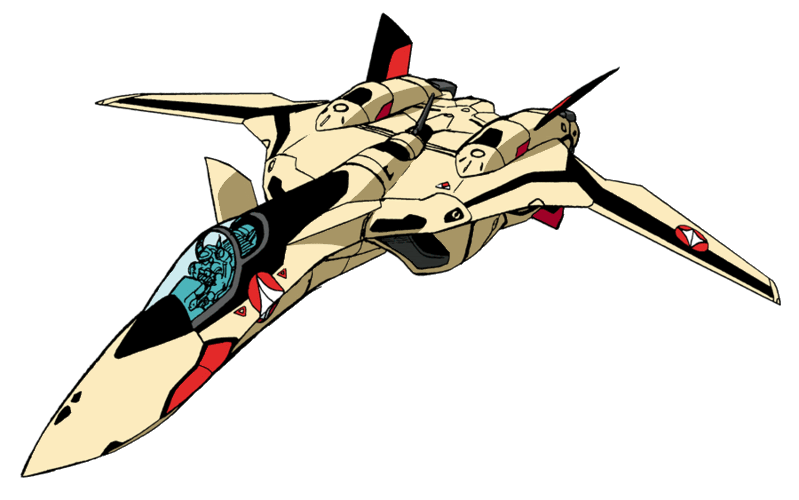
The KE-01 was designed with several technologies that would become the standard for those next generation fighters built by Axe & Hammer to fulfil the operational demands of the DASDF and the TRAF. These technologies included a passive stealth system and a pin-point barrier radar chaff system which could actively identify threats and use the craft countermeasure in an attempt to destroy them. Installed Axe & Hammer shaft turbojet engines provided the KE-01 with impressive thrust. The KE-00 achieved much for Axe & Hammer Industries with a stripped-down, basic design but the KE-01 benefited from advances such that A&H built the craft with much greater standard ordnance. Superior miniaturization and the larger airframe of the KE-01 created space for internal missiles mounted in the engine units that maintained the fighter passive stealth capabilities. With up to four internal missile palettes, the KE-01 additionally utilized a new Howard GU-15 standard external Gatling gun pod. The KE-01 was initially a difficult craft to operate in the testing phase and was flown by seven different test pilots during various trials. Axe & Hammer was nonetheless determined to move forward and the KE-01 achieved incredible success in the Hyper Nova AFP (Advance Fighter Performance), proving that Axe & Hammer could rely upon practical proven methods for a superior next generation variable fighter.

Many DASDF analysts argued that Axe & Hammer’s KE-01 fighter was too traditional in the face of ground-breaking advances implemented in the competing General Galaxy YF-100. Yet by January 5, 2011 the KE-01 (flown by the seventh test pilot, Gau Sylth) produced consistently higher test scores in the fighter competition. Late in the development of both fighters the DASDF halted the Hyper Nova AFP in favour of a secret unmanned fighter project producing the Savage V12 Spectre. However, a training exercise that pitted the V12 Spectre against the YF-100 ended in disaster when the V12 after exhausting its ammunition collided with the VF-100 to eliminate the target. With the YF-100 and V12 Spectre prototypes destroyed in combat, the KE-01 was ultimately declared winner of the Project Hyper Nova AFP in 2012. The craft then entered mass production as the TRAF main fighter.
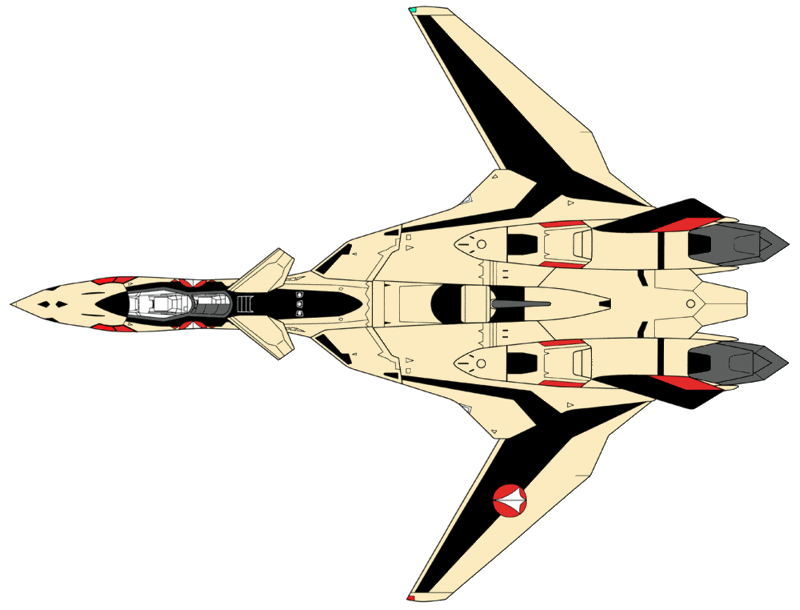
- Armament -
Guns:
1 x Howard GU-15 new standard external Gatling gun pod in single hard point weapon station (mounted ventral fuselage).
Bombs & Missiles:
2 x Stonewell/Roice B-7 standard internal pallets (mounted ventral side fuselage) featuring air-to-air/air-to-ground general-purpose micro-missile pallets
4 x under wing hard points for the mounting of QAAM missiles or laser guided bombs.
4 x chaff dispensers (mounted aft)
Price
KE-01: 85.2 million NSD
Pit Viper Air Superiority Fighter
Fighter Length: 22.77 meters
Mass: empty 17.8 metric tons
Crew: One
Propulsion: 102.5 kN x 2; or 204.7 kN x 2 afterburner; 2 x VTOL high manoeuvrability fan jets operating as supplementary lift fan or high-manoeuvrability jets
Performance: At 11,000 m Mach 2.81; cruising range (with standard micro-missile launcher/auxiliary tank composite pods) 1,910 km; service ceiling 22,500 m.
Design Features: Vertical take-off and landing; multi-axis 90 degree thrust vectoring; extending/retracting main wings; SPO-15C 360° passive radar warning receiver system; 1 x APP-60 chaff and flare dispenser system; RP-51 active stealth system; option of two high-speed, high-manoeuvrability jet boosters equipped with Tapan RD-35A/R composite engines featuring variable nozzles (mounted on over wing hard points).
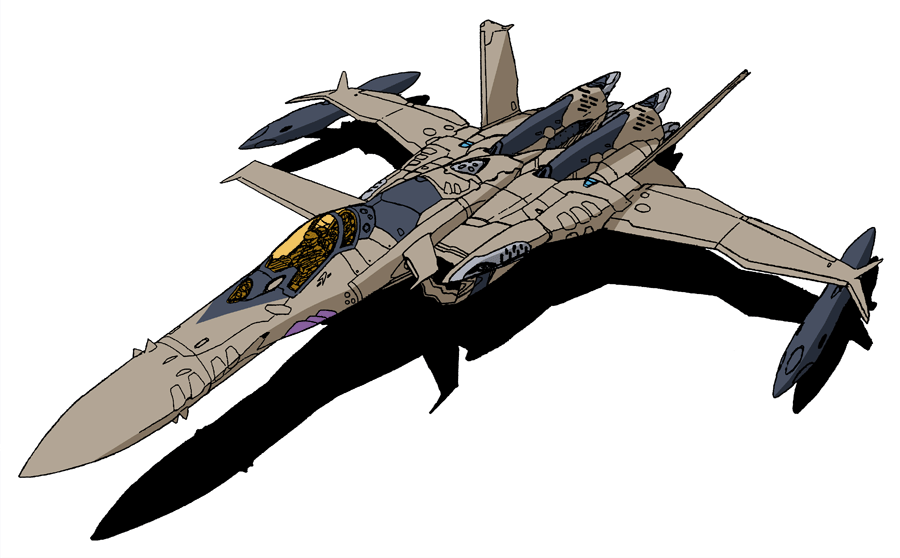
The PV-51 Alpha
The PV-51 is a large fighter with numerous weapons and fully variable systems, the PV-51 utilized one GSH-371 20mm gun pod as its primary weapon. The PV-51 also featured a fixed mini-gun (two in PV-51γ) and six hard points for mounting missile launchers and auxiliary fuel pods. Several additional systems added to the effectiveness of the PV-51 including a high-efficiency active stealth system and two fan jets for VTOL capabilities. In comparison, the CM-0 fighter possessed a lower output stealth system and no such VTOL capabilities. Though the PV-51 enjoys numerous advances over last-generation conventional fighters, the craft does suffer from several design flaws. The size of the aircraft places a burden on the twin engines. The PV-51 has a much shorter range due to high fuel consumption. Rather than cruising to a destination using its own fuel, it is often necessary for the PV-51 to be transported to the operational area typically by an aircraft or helicopter carrier. However, the PV-51 was unlike the hastily combat-equipped CM-0 was considered for use in actual combat from the very beginning.
The PV-51 initially saw very limited production, with 32 mass-production type SV-51α (alpha) units manufactured (a dozen modified into the unsuccessful the SV-52). A further 6 two-seater variants were built and a small number of specially tuned versions designated the SV-51γ (Gamma).
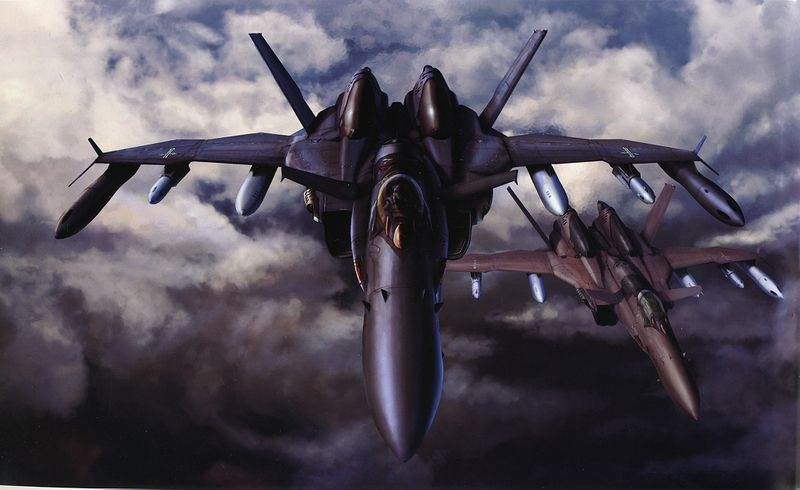
A PV-51 Alpha and Gamma in flight.
- Armament -
Guns:
1 x (2 x in SV-51γ) fixed anti-personnel/light vehicle GSH-231 12.7mm mini-gun (mounted on port intake) with 460 rounds.
1 x GSH-371 20mm gun pod with 220 rounds
Bombs & Missiles:
6 x under wing hard points for 4 x micro-missile launcher/auxiliary tank composite pods with 18 x Turopov SA-19M I/IR-guided micro-missiles (1/point); 2 x R-33D Amos+ medium-range manoeuvring missiles.
or a combination of above load-outs
Optional Armament:
2 x HVAS anti-ship missile
2 x air blast bomb nicknamed "Daisy Cutter."
Pit Viper Air Superiority Fighter – Booster Variant
The PV-51 Booster is a minor variant of the standard fighter fitted with two composite engine jet boosters for increased speed and acceleration. In an unorthodox design choice, the two boosters are installed on over wing hard points and thus allows the PV-51 Booster to utilize all six under wing hard points for munitions and fuel pods. Equipped with the two Tapan RD-35A/R jet boosters, the PV-51 can achieve Mach 3.22 but at the cost of a shorter operational range. The twin boosters also boast two operational modes allowing the pilot to choose between turbofan jet and ramjet for additional propulsion.
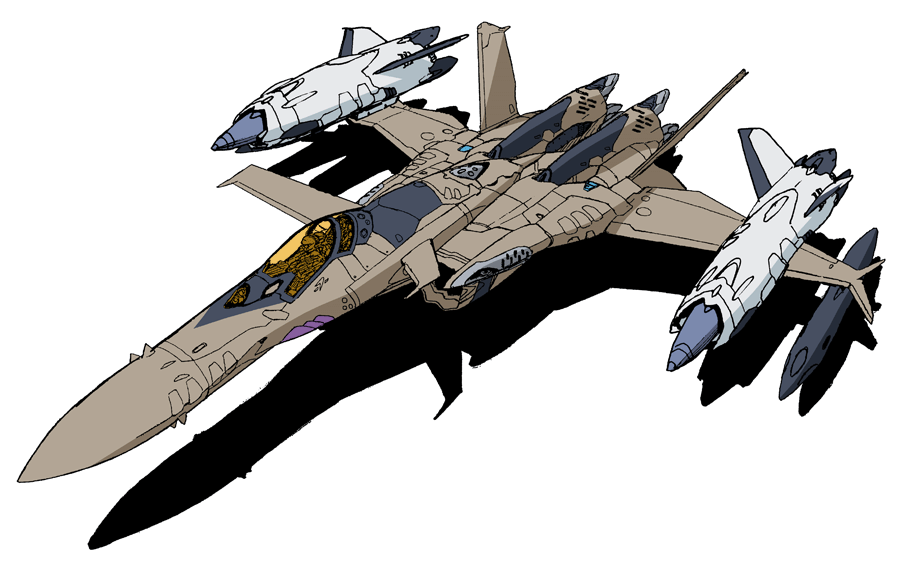
The PV-51 Alpha fitted with the optional Booster Units
Price
PV-51α: 70.1 million NSD
PV-51γ: 71.3 million NSD
PV-51 Booster Variant: 83.2(α) / 84.4(γ) million NSD
Fox Hound 23 Interceptor
Dimensions: Wingspan 15.36 meters; height 4.04 meters; length 19.62 meters
Mass: Empty 9.55 metric tons
Crew: One
Propulsion: 41,200 kg x 2 class maximum instantaneous thrust (91.61 kN x 2)
Performance: Cruise speed Mach 1.75 at 10,000.
Design Features: Variable camber wing; enhanced version Queadluun-Rau special inertia vector control system; two flight configuration modes (cruise and high speed) achieved via varying the cant of wing/tail surfaces; three-dimensional thrust vectoring with three exhaust nozzle flaps on each engine (independent pivot); fighter-scale pin-point barrier radar chaff system (PPB); passive stealth system.
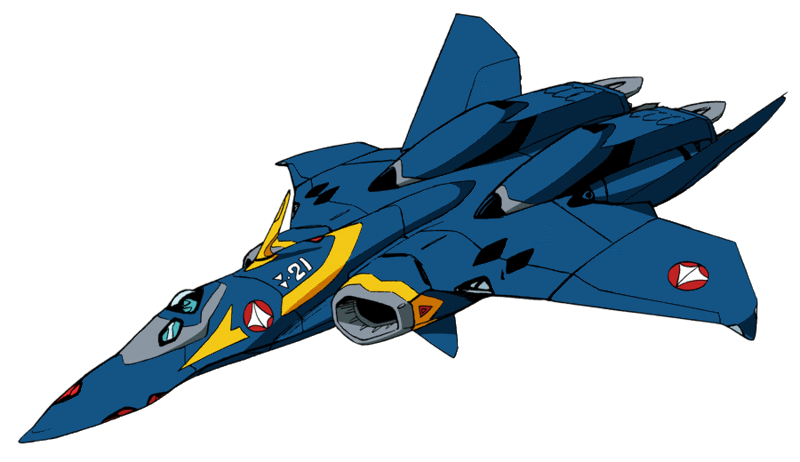
The FH-23 was built with several technologies common to itself and the KE-01; notably a passive stealth system and the pin point barrier radar chaff system. Odom Aerospace Technology was also implemented in the FH-23 by adopting an enhanced version of the Queadluun-Rau special inertia vector control system. The offensive weaponry of the FH-23 includes all-environ rapid-fire micro-missile launchers and lastly two Howard/General GV-17L cartridge-less Gatling gun pods featuring retractable passive stealth covers. In test sorties the FH-23 achieved performance results far beyond last generation fighters and the Advanced Pilot Interface System (APIS) was clearly a recognizable improvement over conventional control systems. The FH-23 made use of variable wing cant for incredible speed. The limiter-release mode can attain performance reaching the fuselage design limits and attain high manoeuvrability combat performance exceeding other fighters. However, the pilot operating the limit-release mode bears the effect of dangerous G-forces which exceed the limits of the human body. While the FH-23 was a ground-breaking fighter, development of the craft was hindered by several misfortunes and technologies of questionable practical worth that were either unreliable (APIS/Limit-Release) or too expensive for mass production (composite material wing).

In January 2012 the problems of the FH-23 began appearing more frequently. Test pilot Akito Ammano suffered temporary loss of control of the FH-23 prototype No. 2 in the first fire control system test, which some attributed to failings inherent in the delicate APIS systems in which control can be lost when a pilot has a neurochemical imbalance. Since this all design flaws of the FH-23 have been smoothed out and the craft has entered mass production.
- Armament -
Guns:
2 x Howard/General GV-17L new cartridge-less Gatling gun pods featuring retractable passive stealth covers in Four hard point weapon stations (mounted left/right ventral fuselage)
1 x fixed A&H PBS-03F fighter-carried pin-point barrier radar chaff system
Bombs & Missiles:
4 x internal Bifors BML-02S FH-23-exclusive all-environment rapid-fire micro-missile launchers featuring exit ports from forward dorsal section to the sides of the engine nacelles (mounted in central dorsal section).
Price
FH-23: 92 million NSD
Taipan 503 High Altitude Interceptor
Fighter Mode: Length 14.03 meters
Mass: Empty 8.3 metric tons
Crew: One
Propulsion: 12,500 kg [x g] x 2 (122.63 kN x 2); 2 x vertical two-dimensional vectored exhaust nozzles.
Performance: At 13,000 m Mach 3.73+
Design Features: Blended wing body; holographic HUD on canopy; variable geometry sweep (VG) wing; single-axis thrust vectoring.
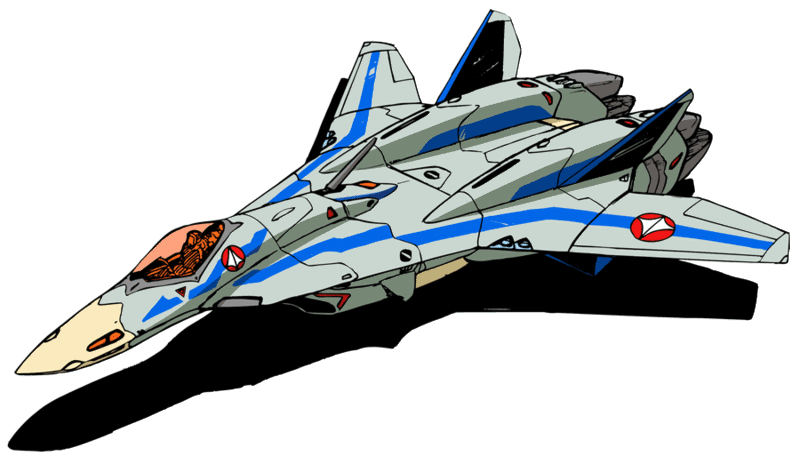
In 2008 Axe & Hammer and Odom Aerospace began a joint project to design a general-purpose lightweight interceptor fighter. The project would also utilize new research a variable fighter that would simplify maintenance and be built in comparatively low numbers once mass production began. When Odom Aerospace merged and became a part of Axe and Hammer in 2009, the T-503 officially became the new departments’ first development project and mass-produced fighter. The first flight of the T-503 took place in 2012 and mass production began only six months later in November 2012. To the surprise of many, some branches of the Denengrad Air Self Defence Force and the Vincin Royal Air force complemented or replaced their main fighters with the T-503 rather than the T-504 Striker II, a decision influenced primarily by the significantly lower cost and greater manoeuvrability of the T-503.

The T-503 project was a success and produced an extremely lightweight next-generation fighter. The T-503 began a trend in lightweight variable fighter design that sadly lasted no more than a year. The T-503 was designed primarily as a lightweight Interceptor due to its weight and thrust output, it is capable of extended combat but it is wise to launch all missiles and then retreat. At only 8.3 metric tons and producing 25,000 kg of thrust, the T-503 achieves speed and manoeuvrability beyond the most optimistic performance tests. For combat, the Taipan-503 features less direct-fire weaponry than other fighters and is armed with only a single gun pod. However, the T-503 is the first mass-produced fighter from Axe & Hammer to incorporate internal missile bays, featuring four micro-missile launchers mounted in the engine sections and the ventral fuselage. This innovative armament design was somewhat ahead of its time and was not adopted by any other aircraft produced by Axe & Hammer Defence until the introduction of the VK-15N-D.
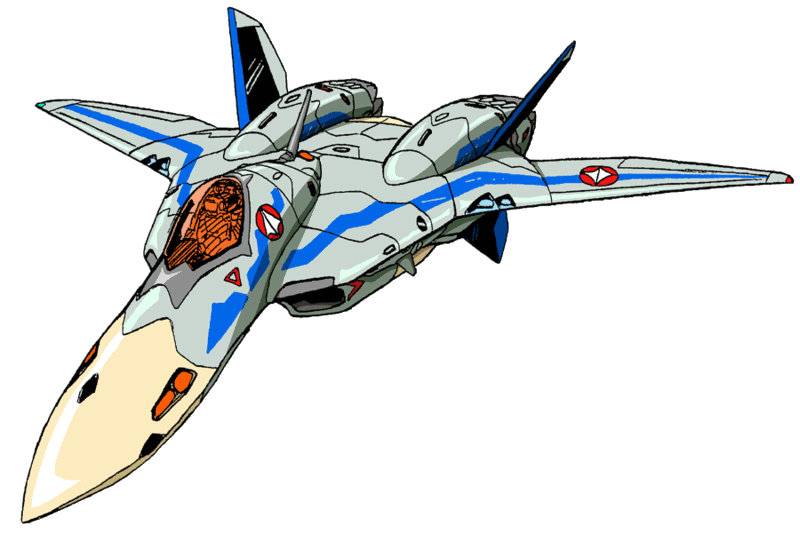
- Armament -
Guns:
1 x standard external EDM-22 20mm multipurpose gun pod (mounted ventral fuselage)
Bombs & Missiles:
4 x internal micro-missile launchers (two launchers mounted in the center ventral fuselage; two launchers mounted in engine sections.
Chaff and flare dispenser system (mounted within either engine section)
Price
T-503: 58.8 million NSD
Rattle Snake 77 Messiah Tactical Fighter
Dimensions: Wingspan 15.5 (fully extended); height 4.03 meters; length 18.72 meters.
Mass: Empty 8.45 metric tons
Crew: One
Propulsion: 2 x 88 kN A&H shaft turbo engines.
Performance: At 10,000 m Mach 3.0, maximum speed due to heat-resistance limit of the fuselage.
Design Features: Variable geometry wing; boundary layer control (BLC); ISC (Inertia Store Converter): Axe & Hammer self-development specification ISC/TO21; active stealth system antennae; chaff/flare/smoke discharger system; thrust reverser equipped with three-dimensional manoeuvring nozzles, AA/AS/SF-06 integrated radar (mounted in nose).
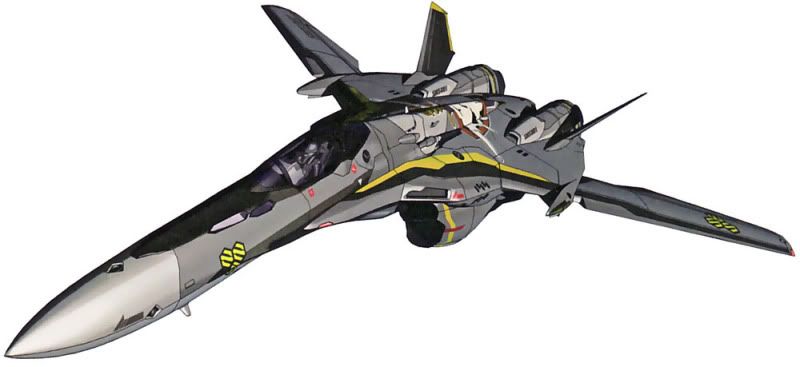
Nearly as much throwback as it is next generation, the RS-77 Messiah is the new fighter developed independently by Axe & Hammer Defence for the sole defence of the NFFE and allied Nations, built from the RS-70 prototype, the Messiah was built as the potential successor to the VK-151 Nightmare Plus, the main fighter of the DASDF special brance, still in active service as of today. The offensive weapons of the RS-77 are many, being armed with a new model gun pod, multiple new missile systems and back up guns. The RS-77 utilizes a pin-point barrier radar detection system for defense that is linked with all countermeasure systems, but is also equipped with a new G-force Inertia Capacitor (ISC) and EX-Gear system which supports the pilot by reducing the effects of acceleration. With this new ISC/EX-Gear operational systeml, the RS-77 is capable of more advanced air manoeuvres than most other craft.

By far the most impressive capability of the RS-77 is the fighters amazing operational versatility, owing much to a design philosophy similar to that of the original VK-15N-D stealth fighter. The Messiah is designed for multipurpose deployment as fighter craft, attack craft and fighter/bomber. The RS-77 achieves success in these varied operational roles by exchanging modules, which allow different pilots to utilize the mission specific characteristics of the customized Messiah unavailable in the standard model. The RS-77 customized configurations include the RS-77G designed for long range intercept missions and the RRS-25 with enhanced electronic warfare capabilities. The RS-77 Messiah has not yet been adopted by the DASDF of NFFE forces, but has been mass produced by Axe & Hammer Strategic Military Services (AHSMS) for field testing in real combat scenarios.
RRS-77
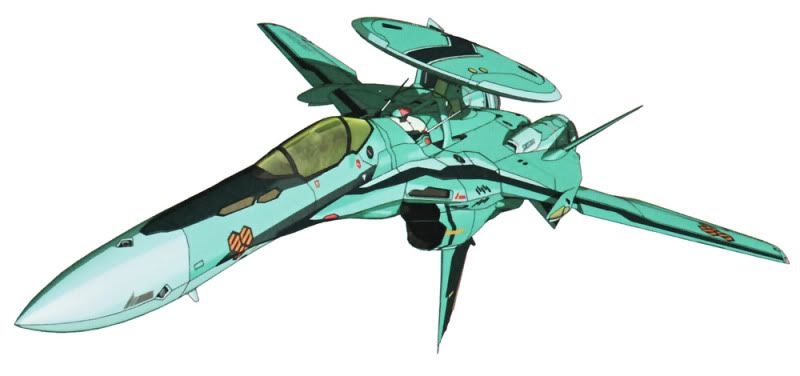
RS-77 Version with enhanced electronic warfare capabilities and equipped with large-sized radome and folding sensor fin. Can control up to 3 Savage V13 Spectre AI Drones.
It detects targets using electromagnetic waves. It can identify up to 208 targets simultaneously and can guide long to medium-range missiles at 62 targets at the same time. Because electromagnetic waves are applied to the control scheme, the control of Savage V13 Spectre Drone series is not possible at long distances without lag time, thus it is wise to let any Savage V13 Spectre drones act autonomously at long range.
Due to the addition of a radome and sensor fin the overall performance of the RRS-77 is severely limited, as such this version should avoid direct combat situations.
- Armament -
Guns:
1 x fixed Mauler RÖV-127C coaxial 20mm mini-gun gun (mounted cockpit right)
1 x Howard GU-17A new model 5-barrel 30mm Gatling gun pod with retractable cover to provide air cooling for the barrels (mounted ventral fuselage)
1 x pin-point barrier radar and countermeasure system
Bombs & Missiles:
4 x under wing hard points for anti-ship missiles.
6 x under wing hard points for QAAM missiles
Or - 6 long range high velocity missiles
Or - 6 medium range air-to-air missiles
Or - Any combination of the above
Price
Please Remember, this Fighter is only for sale to members of the NFFE or Allied nations!
All sales request will be subject to review by member nations of the NFFE
RS-77: 120.3 million NSD
RS-77G: 124.1 million NSD
RRS-77: 132.8 million NSD
Vampire Knight 15 Nightmare Stealth Fighter
Fighter: Wingspan 14.18 meters; height 3.68 meters; length 15.63 meters
Mass: Empty 11.85 metric tons
Crew: One
Propulsion: 55,000 kg [x g] x 2 (539.55 kN x 2); 2 x horizontal two-dimensional vectored exhaust nozzles. Thrust-to-weight ratio: (empty) 9.28
Performance: At 10,000 m Mach 2.4
Design Features: Variable geometry sweep (VG) wing (featuring sawtooth delta wing in standard cruising configuration); wrap-around imaging monitor screens; passive stealth system; two-dimensional (horizontal) thrust vectoring; option of external miniature radome (mounted on dorsal fuselage).
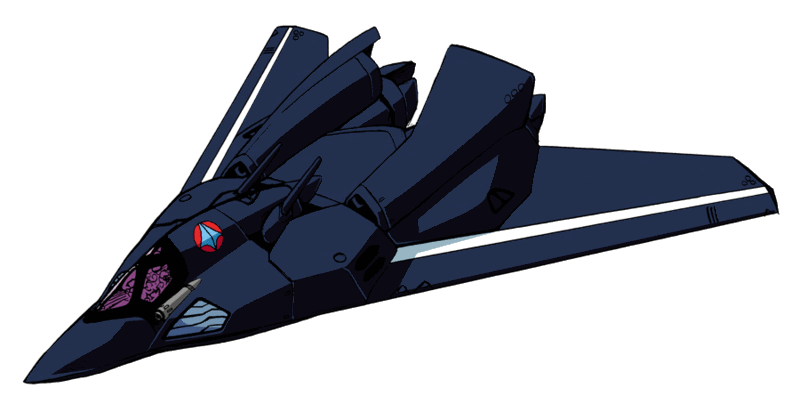
The VK-15 Nightmare is a radically different stealth fighter than previous generations, featuring completely new wing systems. Primarily designed as a special operations stealth fighter, the VK-15 is both larger and heavier than most A&H fighters. To offset the nearly 12 ton weight, the VK-15 operates two extremely powerful Shinnakasu Heavy Industry/P&W/Roice FF-2100X shaft turbine engines with over twice as much thrust as the VK-13B. These incredibly powerful engines produce enough thrust for the Vk-15 to theoretically achieve sub-orbit unaided (the first production model fighter to do so, though we do not recommend trying) while also making the craft an ideal stealth fighter. In addition to these powerful flight characteristics, the Vampire Knight typical follows the success of all fighters; the VK-15 was eventually fitted with several equipment packages from Radomes to customized weaponry and Super Pack systems.
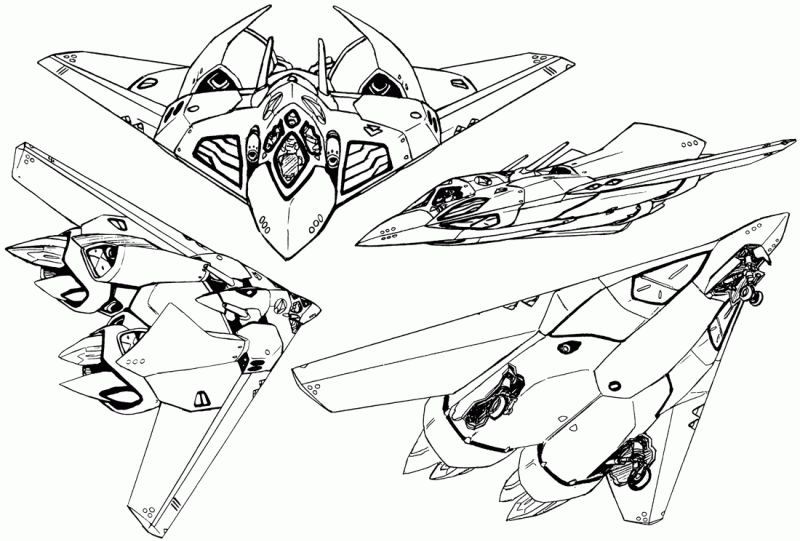
The VK-15 was built in several different versions, but the VK-15D currently in service is the most distinguished model. It was originally the intention of the Vincin Royal Air Force that the VK-15 Nightmare be replaced as the primary special operations fighter of the VRAF by the T-503 (Also an A&H design), the VK-15D has enjoy so much success though that this action has yet to take place. However, work is currently on going to redesign the VK-15 Nightmare into the VK-151 Nightmare Plus, a new main stealth fighter/bomber for the Vincin Royal Air Force.
- Armament -
Guns:
2 x fixed small-bore forward 12mm guns (mounted left/right of cockpit)
Bombs & Missiles:
2 x internal micro-missile launchers (mounted left/right of dorsal main fuselage with two launcher ports each)
2 x internal LGB (laser guided bombs) / QAAM (Quick air to air manoeuvre missiles) bays
Optional Armament:
Internal standard equipment capable of being exchanged for other weapon packs.
1 x miniature radome for stealth surveillance and battle space control.
Price
VK-15N-D: 89.2 million NSD
Vampire Knight 151 Nightmare-Plus Stealth Fighter
Dimensions: Length 15.65 meters
Mass: Empty 12.15 metric tons
Crew: One
Propulsion: 2 x 80.9 kN A&H-AAE-12 Shaft turbo engine (maximum thrust in space)
Performance: Cruising speed at 10,000m Mach 2.5
Design Features: 3-mode variable transformation; variable setting EPM (Electronic Protective Measures); ASS/PS 155 3rd-generation passive stealth system; flare and chaff dispenser system; extended nose and trailing edge on main wing compared to VK-15N-D; increased canopy field-of-view and redesigned aerodynamic characteristics beyond VK-15 Nightmare.
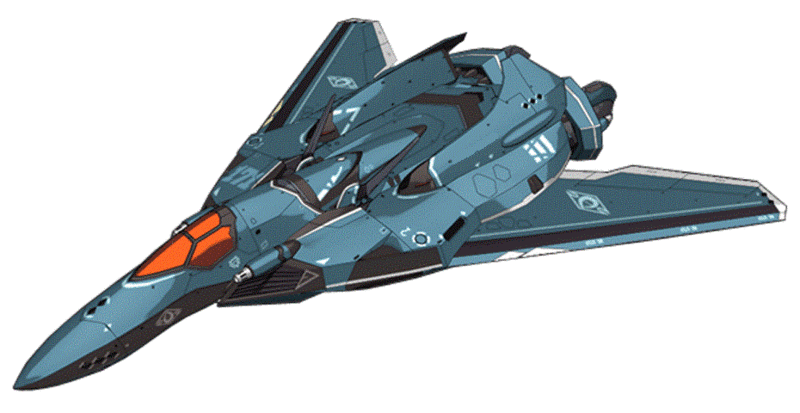
The VK-151 Nightmare Plus is the current main stealth fighter that evolved from the VK-15 Nightmare-D built in the late 1980’s. The VK-15 Nightmare was designed by Axe & Hammer and Odom Aerospace originally as a heavy stealth fighter for special operations, but the New DASDF and OAFD wished to pursue a mass production model of the Nightmare the would be built in far greater numbers. Since the Vk-15N-D Nightmare proved difficult to mass-manufacture, the VK-15 Nightmare was redesigned in 2005 as a comparatively downgraded version that was a more cost effective option to procure. While effectively a lesser version of the VK-15 Nightmare, the VK-151 Nightmare Plus has also been improved and modified to extend the craft's service and enhance manoeuvrability. In building the VK-151 Nightmare Plus, the most outwardly noticeable changes Axe & Hammer made were to extend the nose and enlarge the cockpit canopy for a superior field-of-view. The engine units were also redesigned and the main wing and fuselage were changed for improved aerodynamic characteristics. Lastly, the defensive capabilities of the VK-151 were also strengthened and the Nightmare Plus features a pin-point barrier radar chaff dispenser.
Designed so that even average pilots can operate the craft effectively in multiple roles, the VK-151 Nightmare Plus is deployed as fighter/bomber. With a variety of optional hardware available, the VK-151 Nightmare Plus is a low cost and versatile fighter.
- Armament -
Guns:
2 x Mauler REB-22 15mm mini-gun cannons
Bombs & Missiles:
2 x Bifors BML-02S micro-missile launchers (mounted in main fuselage near the wing root)
6 x under-wing hard points for additional armaments and missile pods; capable of mounting 2 x anti-ship missiles
Ordnance container loading system located in engine nacelle unit
Price
VK-151N-P: 98.1 million NSD
Star Wing 9 Command Stealth Bomber
Bomber: Length 75 meters, Wingspan 145 meters (SW-9 requires custom built heavy duty runway)
Mass: Empty 77.2 metric tons
Crew: Three
Propulsion: 4 × A&H C198-VE-100 non-afterburning turbofans, 22,300 lbf (114 kN) each.
Performance: Mach 0.95 at 14,000 meters altitude, Service ceiling 19,200 meters
Design Features: Active stealth systems, radar absorbent surface, rear inward sweep wings for increased climb and manoeuvres. Rotary Launch Assembly; Range: 6,000 nmi (11,100 km (6,900 mi); Thrust/weight: 0.205.

The Star Wing 9 was developed to take over the Tarsian Air forces’ vital penetration missions, able to travel deep into enemy territory to deploy their ordnance, which could include nuclear weapons. The Star Wing is a flying wing aircraft, meaning it has no fuselage or tail. The blending of low-observable technologies with high aerodynamic efficiency and large payload gives the Star Wing significant advantages over previous fixed wing bombers. Low observability provides a greater freedom of action at high altitudes, thus increasing both range and field of view for on-board sensors.
Due to the aircraft's complex flight characteristics and design requirements to maintain very-low visibility to multiple means of detection, both the development and construction of the SW-9 required pioneering use of A.I-aided design and manufacturing technologies. Axe & Hammer is the SW-9's prime contractor; other contributing subcontractors include Odom Aerospace, T.N.S, and Solo Aircraft. The SW-9 bears a resemblance to earlier Odom Aerospace aircraft, the VS-3 and FW-50 were both flying wing bombers that had been cancelled in development in the early 1970s; allegedly for design flaw reasons.
The SW-9 has a crew of three: a pilot in the left seat, mission commander in the right and bomb controller seated behind the two; the SW-9 has provisions for a fourth crew member if needed. The SW-9 is highly automated and, unlike most multi-seat aircraft, two crew members can sleep, use a toilet or prepare a hot meal while the other monitors the aircraft; extensive sleep cycle and fatigue research was conducted to improve crew performance on long sorties.
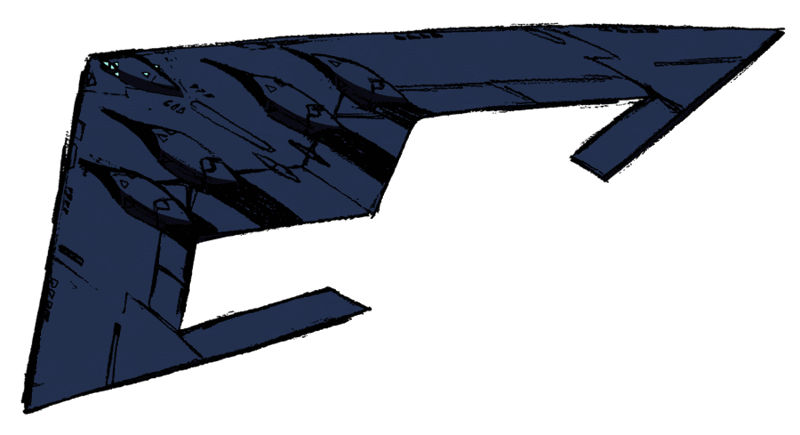
The SW-9 features the low probability of intercept AN/APQ-121 multi-mode radar, a fully digital navigation system that is integrated with terrain-following radar and Global Positioning System (GPS) guidance, and a Defensive Management System (DMS) to inform the flight crew against possible threats. The on-board DMS is capable of automatically assessing the detection capabilities of identified threats and indicated targets.
For safety and fault-detection purposes, an on-board test system is interlinked with the majority of avionics on the SW-9 to continuously monitor the performance and status of thousands of components and consumables; it also provides post-mission servicing instructions for ground crews. In 2010, many of the standalone distributed computers on board the SW-9, including the primary flight management computer, were being replaced by a single integrated system.
In order to address the inherent flight instability of a flying wing aircraft, the SW-9 uses a complex quadruplex computer-controlled fly-by-wire flight control system, that can automatically manipulate flight surfaces and settings without direct pilot inputs in order to maintain aircraft stability. The flight computer receives information on external conditions such as the aircraft's current air speed and angle of attack via pitot-static sensing plates, as opposed to traditional pitot tubes which would negatively affect the aircraft's stealth capabilities. The flight actuation system incorporates both hydraulic and electrical servoactuated components, it was designed with a high level of redundancy and fault-diagnostic capabilities.
The SW-9's low-observable, or "stealth", characteristics enable the safe penetration of sophisticated anti-aircraft defences and to attack even heavily defended targets. This stealth comes from a combination of reduced acoustic, infrared, visual and radar signatures to evade the various detection systems that could be used to detect and be used to direct attacks against an aircraft. The majority of the SW-9 is made out of a carbon-graphite composite material that is stronger than steel and lighter than aluminium, perhaps most crucially it also absorbs a significant amount of radar energy. The SW-9has a radar signature of about 0.5 m
-Armament-
2 internal bays for 70,000 lb of ordnance.
86× 500 lb class bombs mounted on Bomb Rack Assembly (BRA)
40× 750 lb DSP class bombs on BRA
18× 2000 lb class weapons mounted on Rotary Launcher Assembly (RLA)
18× nuclear weapons on RLA
Price
SW-9C: 729 million NSD
Cat’s Eye 4 Reconnaissance Fighter
Fighter: Wingspan 12.65 meters; height 5.31 meters; length 16.8 meters
Mass: Empty 13.95 metric tons
Crew: One
Propulsion: 14,000 kg [x g] x 2 (137.34 kN x 2); P&W HMM-1A high-maneuverability vernier thrusters
Thrust-to-weight ratio: (empty) 2.01 (rating for turbine engine thrust ONLY)
Performance: At 15,000 m Mach 5.15
Design Features: Wing-mounted engines; canard forward wing; inward-canted vertical stabilizers to deflect radar reflections; nose-mounted ventral fin; two-dimensional thrust vectoring; variable main wings and nacelle ventral fins for high-speed flight; nose canards and ailerons; ram-Wing nozzle in the aft section of fighter fuselage functions as air brake; three-hull structure ensures airframe's capacity.
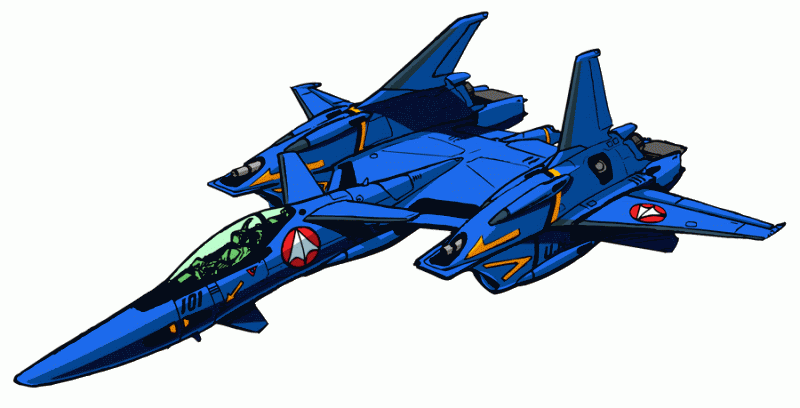
Built as a reconnaissance craft, the CE-4 primary weapons became two mid-sized 25mm mini-guns, though the craft is capable of carrying a GU-11 gun pod under the main body. In addition to the powerful primary guns, the Cat’s Eye 4 also features four semi-recessed long-range missiles as well as under wing pylons for additional missiles. The CE-4 was only slightly heavier than the CE-3, but featured considerably more powerful engines making the craft ideal for operations deep within enemy airspace at high altitude. The CE-4 was also much faster at altitude than the older CE-3 though the CE-4 flight mobility performance was not as great. The CE-4 is also notable as the first production reconnaissance fighter to utilize a HOTAS system (Hands On Throttle And Stick) for the cockpit HMI (Human-Machine Interface). The CE-4's cockpit was also built as a single hexagonal MFD (Multi-Function Display) that proved so successful it was retrofitted into PV-51 fighters as well as providing the template for all future fighter cockpits produced by A&H.
The CE-4 sensor package includes optical/infrared imagery systems; side-looking airborne radar (SLAR); electronic intelligence (ELINT) gathering systems; defensive systems for countering missile and airborne fighters; and recorders for SLAR, ELINT and maintenance data. The CE-4 carries a Spy-Eye tracking camera and an HAS Singer infrared camera, both of which run during any mission for route documentation, and to respond to any accusations of overflight

By the end of 2003, mass production of the CE-3 series at last came to an end. From 2010 onward, the CE-4 officially replaced the CE-3 to become the main reconnaissance fighter of D.A.S.D.F. A trial-produced variable fighter, designated the CE-4A-0, was also built using 25% CM-0 parts. Production of the CE-4 continues with a total of 361 reconnaissance fighters produced for D.A.S.D.F and other forces.
Life Support
Flying at 30,000 m meant that pilotss could not use standard masks, which could not provide enough oxygen above 13,000 m. Specialized protective pressurized suits were produced by the DFSP Company for the CE-3 and CE-4; Furthermore, an emergency ejection at Mach 5.15 would subject crews to an instant heat rise of about 270 °C; thus, during a high altitude ejection scenario, an on-board oxygen supply would keep the suit pressurized during the descent. During flight the cabin needed a heavy-duty cooling system, for cruising at Mach 3.2+ would heat the aircraft's external surface well beyond 260 °C and the inside of the canopy to 120 °C. An air conditioner used a heat exchanger to dump heat from the cockpit into the fuel prior to combustion.
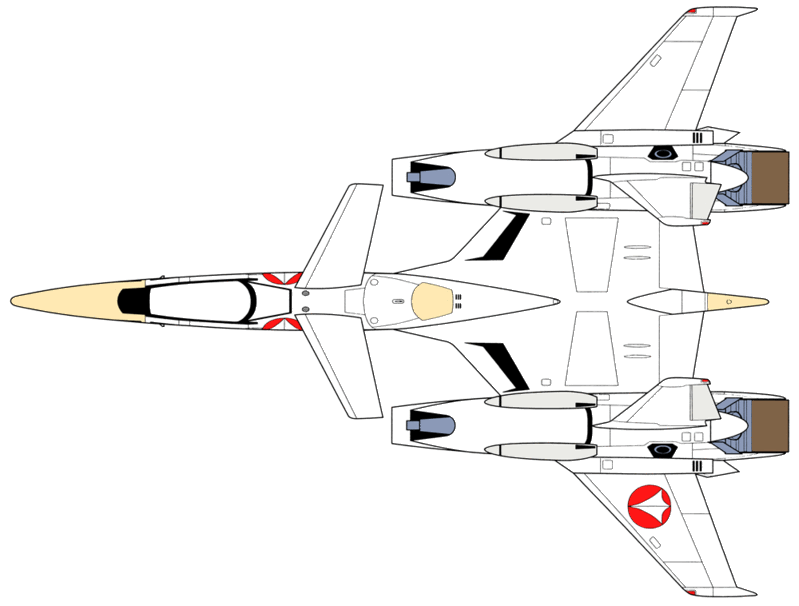
- Armament -
Guns:
2 x mid-sized 25mm mini-guns (mounted in forward engine nacelles, 400 rounds each, adjustable rds/min.
Bombs & Missiles:
4 x semi-recessed long range missiles (mounted on engine nacelles and ventral fuselage)
2 x under wing pylons for missiles
Optional Armament:
1 x Howard GU-11 55 mm three-barrel Gatling gun pod with 200 rds fired at 1,200 rds/min
Price
CE-4: 98.5 million NSD
Eagle Eye 2 Alpha Surveillance Aircraft
Length: 32.74 m
Wingspan: 16.94 m
Height: 5.64 m
Crew: Two
Propulsion: 52,500 kg x 2, (151 kN each).
Thrust-to-weight ratio: (empty) 8.33
Performance: standard cruising speed at 31,000 m Mach 4.5
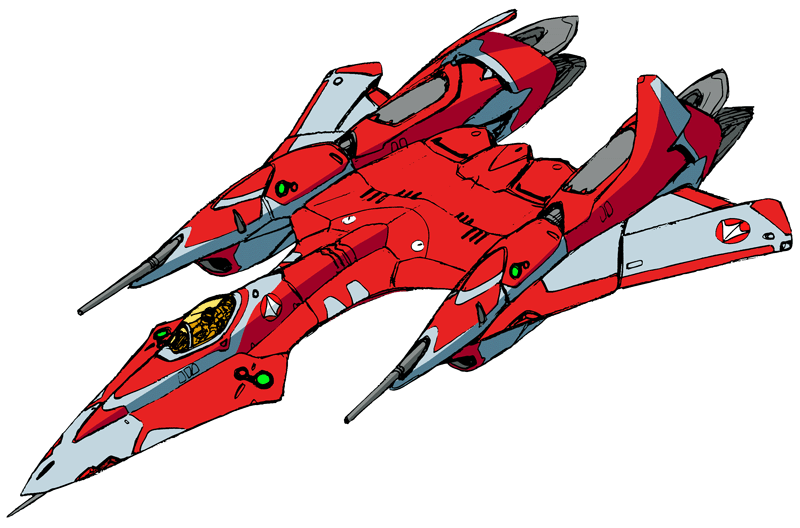
The unique design that gives the EE-2A its remarkable performance also makes it a difficult aircraft to fly. It was designed and manufactured for minimum airframe weight, which results in an aircraft with little margin for error. Most aircraft were two-seat versions, with only five three trainer versions known to exist. Early EE-2 variants were powered by TNS J57 turbojet engines. The EE-2 and EE-2A variants used the more powerful incorporated A&H F118 turbofan engines.
Low-aspect-ratio wings give the EE-2A no glider-like characteristics. To maintain their operational ceiling of 21,000 m, the EE-2A must fly very near their maximum speed. The aircraft's stall speed at that altitude is only 10 knots (12 mph; 19 km/h) below its maximum speed. This narrow window was referred to by the pilots as the "coffin corner". For 90% of the time on a typical mission the EE-2A was flying within only five knots above stall, which might cause a decrease in altitude likely to lead to detection, and additionally might overstress the lightly built airframe to the point of fracture.
The EE-2A's flight controls are designed around the normal flight envelope and altitude at which the aircraft was intended to fly. The controls provide feather-light control response at operational altitude. However, at lower altitudes, the higher air density and lack of a power-assisted control system makes the aircraft very difficult to fly. Control inputs must be extreme to achieve the desired response in flight attitude, and a great deal of physical strength is needed to operate the controls in this manner.
The EE-2A is very sensitive to crosswinds which, together with its tendency to float over the runway, makes the EE-2A notoriously difficult to land. As the aircraft approaches the runway, the cushion of air provided by the low-lift wings in ground effect is so pronounced that the EE-2A will not land unless the aircraft is fully stalled. To assist the pilot, the landing EE-2A is paced by a chase car (usually a "souped-up" performance model) and with an assistant (another EE-2A pilot) who "talks" the pilot down by calling off the angles and declining height of the aircraft in feet as it decreases in airspeed. Cars used have been Ford Mustang SSP, Chevrolet Camaro B4C, Pontiac GTO, Pontiac G8 GT), and (as of 2012) 20 standard Chevrolet Camaro SS perform the landing assistance worldwide.
Because of the high operating altitude and the EE-2A's cockpit partial pressurization, equivalent to 29,000 feet, the pilot must wear the equivalent of a space suit. The suit delivers the pilot's oxygen supply and emergency protection in case cabin pressure is lost at altitude (the cabin provides pressure equivalent to about 29,000 feet / 8,800 meters). To prevent hypoxia and decrease the chance of decompression sickness, pilots don a full pressure suit and begin breathing 100% oxygen one hour prior to launch to remove nitrogen from the body; while moving from the building to the aircraft they breathe from a portable oxygen supply. Despite these measures, more than a dozen pilots have suffered the effects of decompression sickness since 2001; nine were reported to have suffered permanent brain damage. Inability to read fine print and inability to recognize the landing field upon return from a mission were among the symptoms. These cases were rare prior to 2001. Factors increasing the risk of illness have included longer mission durations, and more activity in the cockpit. For reconnaissance missions the pilot's duties were limited to maintaining flight path while the cameras took pictures; more recently EE-2A pilots communicated in real time with ground troops and carried out more tasks in the cockpit, increasing their bodies' oxygen requirements and the risk of nitrogen bubbles forming in capillaries. Axe & Hammer is studying the issue; EE-2A pilots now exercise during oxygen pre-breathing. Among other remedies proposed is increasing cockpit pressurization to an equivalent of 15,000 feet.
The aircraft carries a variety of sensors in the nose, Q-bay (behind the cockpit, also known as the camera bay), and wing pods. The EE-2A is capable of simultaneously collecting signals, imagery intelligence and air samples. Imagery intelligence sensors include either wet film photo, electro-optic or radar imagery – the latter from the Raytheon ASARS-2 system. It can use both line-of-sight and beyond-line-of-sight data links. One of the most unusual instruments in the newest version of the EE-2A is the off-the-shelf Shony video camera that functions as a digital replacement for the purely optical viewsight (an upside down periscope-like viewing device) that was used in older variants to get a precise view of the terrain directly below the aircraft, especially during landing.
Price
EE-2A: 197.1 million NSD
Wild Weasel Combat Helicopter
Length: 16.6 meters
Mass: 6.2 tons empty
Crew: two
Propulsion: x2 ADM turbo shaft jet engines
Performance: Top speed of 298mph at low and mid altitude, rage of 500 miles
Design Features: Passive radar warning system, laser and radar tag warning system, rate of climb 10.5 m/s, service ceiling of 4000 meters, disc area of 147 meters square, chaff and flare dispenser, ECM suit.

The body of the Wild Weasel is made from 80% carbon fibre reinforced polymer and Kevlar, 11% aluminium, and 6% titanium. The rotors are made from fibre-plastic able to withstand combat damage and bird strikes. Protection against lightning and electromagnetic pulse is ensured by embedded copper/bronze grid and copper bonding foil.
While the Wild Weasel has a conventional helicopter gunship configuration of the two crew sitting in tandem, it is somewhat unusual in that the pilot is in the front seat and the gunner is in the back, unlike all other current attack helicopters. The seats are offset to opposite sides of the centreline to improve the view forward for the gunner in the back.
Crews coming to the Wild Weasel from other platforms require additional training because the additional capabilities bring a higher workload

The Weasel’s armour can withstand 23 mm auto cannon fire. The helicopter includes the AN/AAR-60 MILDS System developed by TNDS. It includes radar warning, laser warning, and a missile launch/approach detector systems and is connected to a central processing unit from DFDS and a SAPHIR-M chaff/flare dispenser from A&HD. The Weasel’s visual, radar, infrared, sound signatures have been minimised.
The navigation system contains two DFDS Avionique three-axis ring laser gyro units, two magnetometers, two air data computers, JFA Systems CMA 2012 four-beam Doppler radar, radio altimeter, global positioning system, and a suite of low air speed sensors and sensors for terrain-following.
Datalinks systems are Link 4A, DFDS Proprietary PR4G, and STANAG 5066. Its radios are HF, MF, VHF, UHF, military SATCOM, and GPS receiver.
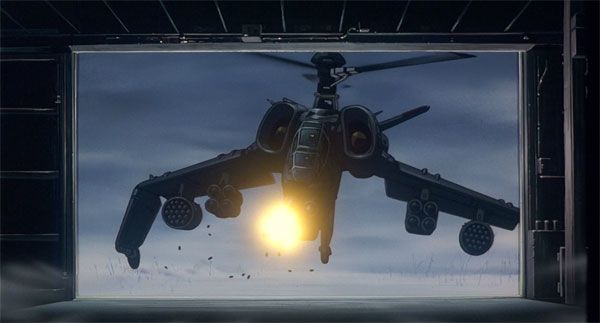
Electronic Warfare
The electronic warfare (EW) system of Weasel is the first Kistan EW system that integrates the radar, radar warning receivers (RWR), laser warning receivers (LWR), electronic support measures (ESM) and electronic counter-measures (ECM) together. The system is designated YH-78 (YH = Yu Huo). YH-78 has a high interception rate of hostile signals, and in the fully automatic mode, it can automatically analyse the threat and launch different decoys and jamming signals accordingly. Alternatively, pilots can choose to launch decoys or jamming enemy sensors themselves.
Like the modified Blue Dawn navigation pod, a modified SR/VG300G self-protection jamming pod can also be carried, usually on one of the hard points of the wings. Similarly, a modified GH900 reconnaissance pod can be carried for reconnaissance missions, although all of these additions come at the cost of reducing the number of hard points available for carrying weaponry. Usually, only one of such pod is carried at any one time. The identification friend or foe (IFF) system of Weasel is specially designed to work in an environment of heavy enemy jamming. All internally mounted jamming and decoy launching systems are built with the concept of modular design, so that they can be readily replaced when newer technologies become available.
Armament
Guns:
1× 45 mm TNS 40 cannon in belly turret, with up to 450 rounds.
On each of its two inner hard points and two outer hard points the Wild Weasel can carry a combination of the following weapons:
Inner hard points:
1x 20 mm (0.787 in) auto cannon pods, or
22x 68 mm (2.68 in) HVM unguided rockets in a pod, or
19x 70 mm (2.75 in) Cerberus 70 unguided rockets in a pod or
4x AGM-114 High-five missiles or
4x Spiker-SR missiles or
4x PJRS 3 LO missiles or
4x H-0-T3 missiles
Outer hard points:
2x Hornet air-to-air missiles, or
12x 68 mm (2.68 in) SUEB unguided rockets in a pod or
7x 70 mm (2.75 in) Cerberus 70 unguided rockets in a pod
Price
Wild Weasel: - 23.2 million NSD
Name of nation:
Name of ordering person:
When should we deliver?:
Where should we deliver?:
Name and Number of Products:
Total Price:


